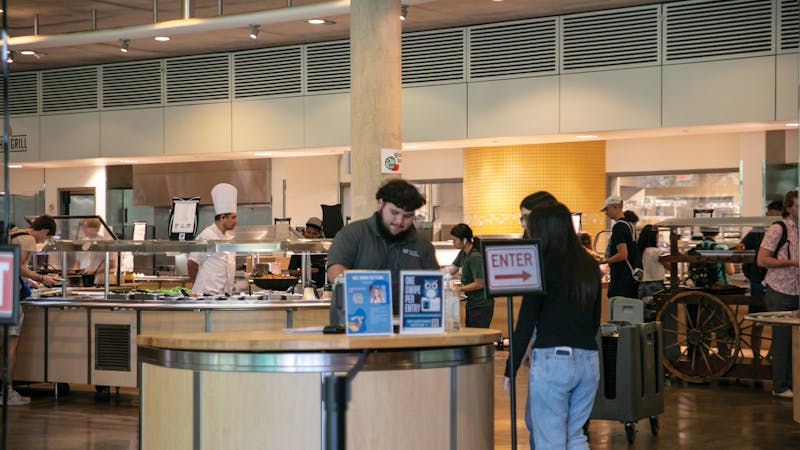Baker College gets LEED Certification
At the turn of Rice's first century, Baker College stands as the oldest residential college on campus with its mix of century-old architecture and modern-day buildings. According to Director of Sustainability Richard Johnson, the recent renovations to the new wing of Baker earned the college a Leadership in Energy and Environmental Design silver certification.
LEED is a program used to rate the environmental performance of a building, Johnson said.
"There are different levels of LEED certification," Johnson said. "The highest is LEED platinum, followed by LEED gold, then LEED silver and, finally, the basic LEED certified."
The LEED program allocates points based on various criteria and prerequisites for certification.
The new Baker wing, whose construction followed the completion of Duncan and McMurtry Colleges, was conceived in 2007, broke ground in 2009 and was completed in August 2010, Project Manager Larry Vossler said. The project included a completely renovated kitchen and servery in addition to a new residential building for Baker, Vossler said.
According to Housing and Dining Senior Operations Manager for Lovett, Will Rice and Baker Colleges Brad Thacker, this project was scheduled around the calendar year to reduce disruption to students.
According to Vossler, the new Baker wing was modeled after the newer residential colleges.
"Having the students live in Duncan and McMurtry was really helpful because it highlighted some unforeseen problems with the new building structure," Vossler said. "We were able to correct these problems for the new wing in Baker and retroactively correct the issues in the newer colleges."
Student feedback on energy saving, ineffective pooling of water and light sensors was taken into consideration. According to Vossler, if a door or window was opened in a McMurtry dorm room, the air conditioning unit would turn off, proving to be an inconvenience for students. In the bathroom pods, the floors frequently collected water because of ineffective leveling of the floors. Lastly, the lights in McMurtry and Duncan were coordinated with wireless sensors, which frequently controlled multiple rooms. In the Baker wing, the sensors were set up individually off-site, allowing them to control each specific room.
Johnson said 89.8 percent of all waste collected during the process was recycled, amounting to a total of 2,188 cubic yards of waste diverted from the landfill. The material was sorted and recycled off-site.
Sustainability at Baker is not limited to the residential college building itself. The new Baker Kitchen employs a farm-to-fork-to-farm process in which the kitchen buys produce from a local farmer and sends back scraps as compost, Manager of Communications for Facilities Engineering and Planning Susann Glenn said. In addition, the green roof provides produce and minimizes runoff, Glenn said.
In 2006, Rice University made the commitment to have every new building LEED certified, thanks to a student group project in ENST 302: Environmental Issues: Rice Into the Future, Johnson said. Since then, the goal has been to have every new building attain at least LEED silver certification.
Sustainability can mean many things, but to Johnson, it involves having buildings stand the test of time.
"My hope is that 100 years from now, the Baker College addition will have also aged just as gracefully and will have remained as functional as the original," Johnson said. "Designing buildings that remain useful for over 100 years is at the heart of what it means to build sustainably."
Associate Vice President for H&D Mark Ditman said this project increased Baker bed spaces from 207 to 248.
Ditman said it is our our responsibility as a community to live sustainably for the future.
"We have to ask ourselves the question if we are willing to spend the extra money to create a sustainable situation that we may not directly benefit from," Ditman said. "It is our moral imperative as a institute of higher education to support [these ventures] and to step up with dollars."
Baker senior Christina Hughes, who is an EcoRep at the college, said the new addition added to the history of Baker.
"In general, though, I think Baker feels a lot nicer since the renovations," Hughes said. "I think it's always had an old-school feel, but the face-lift has just made it more 'shiny' and livable without taking away from the historic feel."
Baker senior Alan Sosa lived in Duncan his freshman year and said he noticed differences between the newer colleges and the new wing of Baker.
"I lived on the third floor of [Duncan] in my freshman year and in the new wing of Baker my sophomore and senior year here at Baker," Sosa said. "The differences are noticeable. [For one,] the bathrooms don't flood [here]."
More from The Rice Thresher

Rice football kicks off Abell era with commanding road win
For the first time since 2018, Rice football opened its season with a victory. Scott Abell was soaked with yellow Powerade following a 14-12 win on the road Saturday against the University of Louisiana at Lafayette, which won 10 games and made it to the Sun Belt Conference championship last season.

Dis-O, move-in weekend see increase in alcohol transports from last year
Rice’s first wet weekend of the year saw four times as many calls for intoxication-related transports of students to the hospital compared to the previous three years, according to emails sent out by college presidents and chief justices.

On-campus meal plan changed to unlimited swipes
Housing and Dining recently revealed a new dining plan for the upcoming semester. The required on-campus meal plan now has unlimited meal swipes, compared to 375 meal swipes last year. H&D said the previous on-campus meal plan was for students who intended to eat on campus 15 to 25 meals a week.

Please note All comments are eligible for publication by The Rice Thresher.